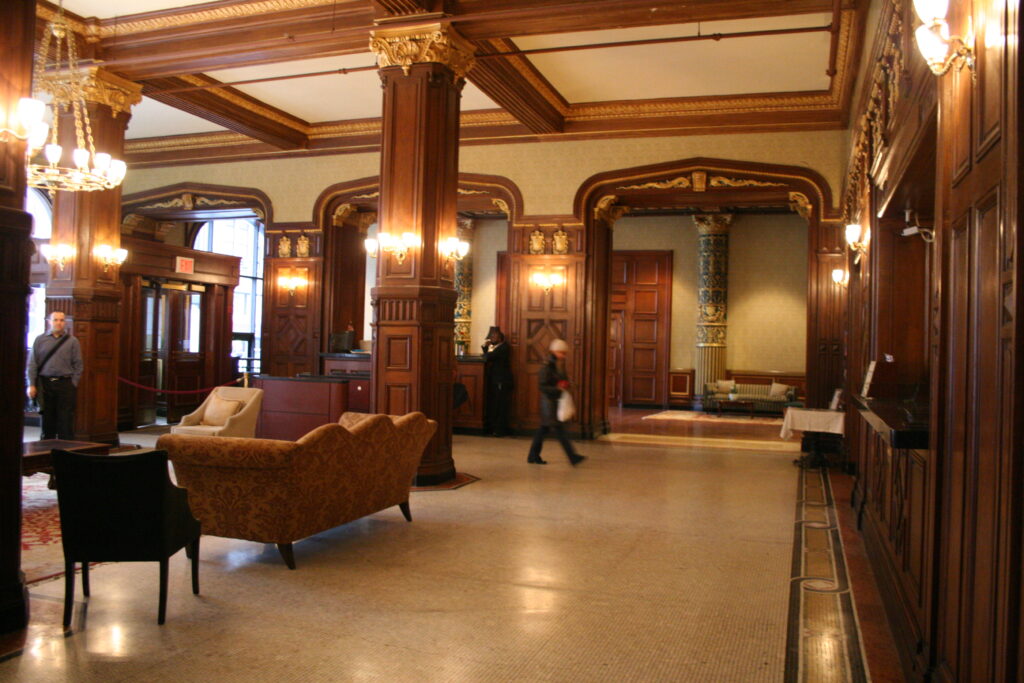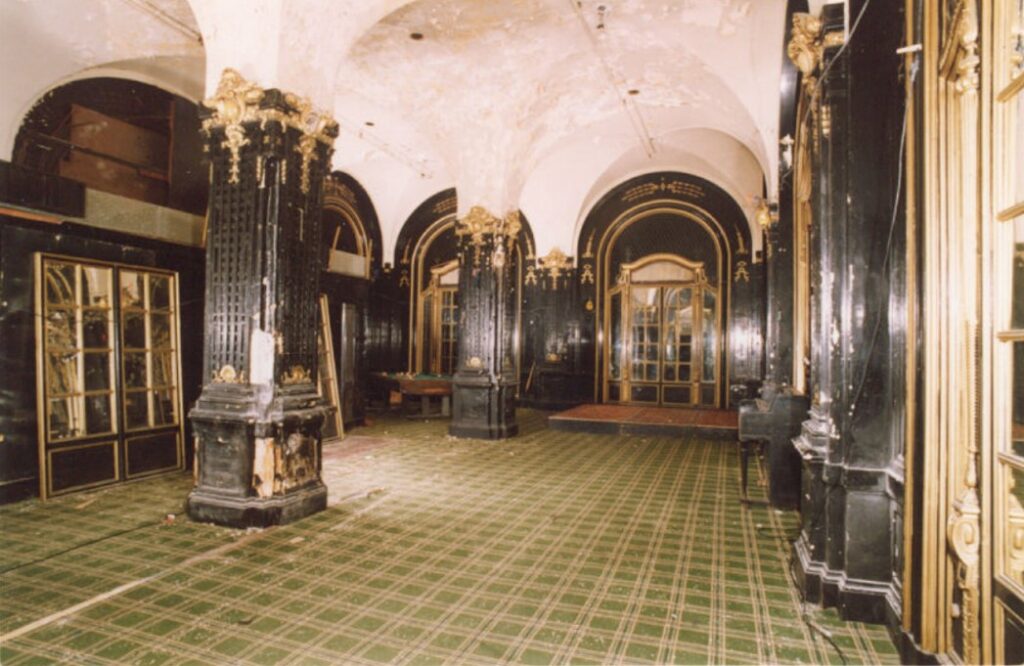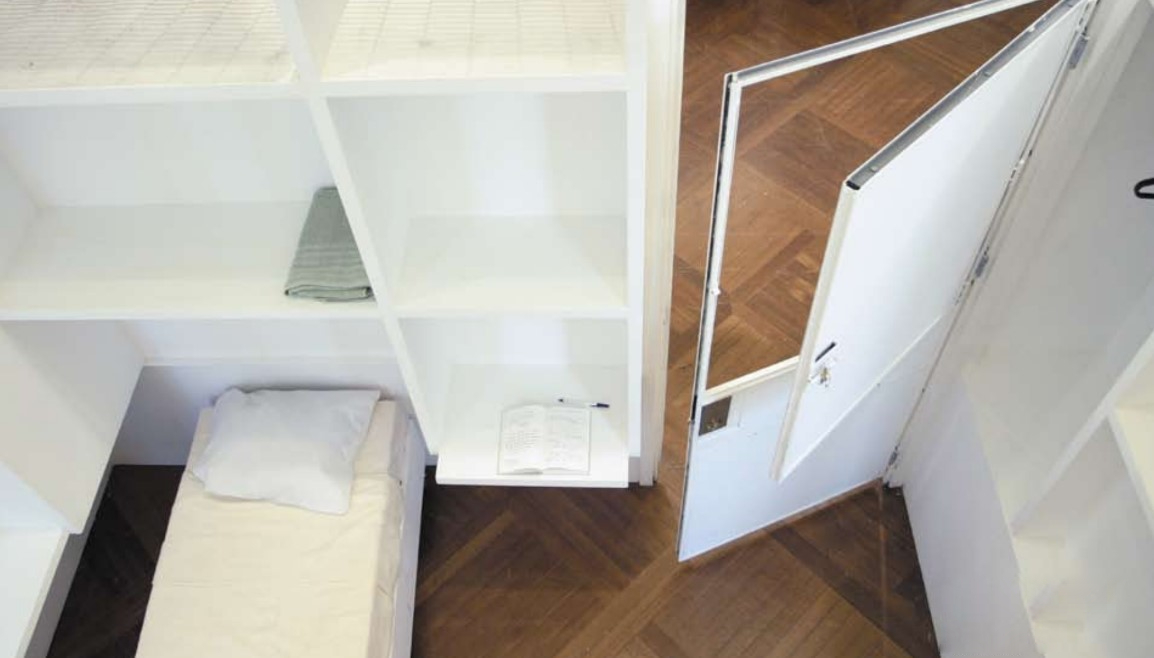
A prototype of the First Step Housing competition entry “The Ordering of Things.” Designed by the New York team of Katherine Chang and Aaron Gabriel, the design was one of two winning schemes to be further developed for use in the renovated Andrews House.
| Location | New York, NY |
| Date | 2001–7 |
| Nonprofit Developer | Common Ground Community, Housing Development Fund Corporation |
| End Client | Homeless and transient population |
| Design teams | Rafi Elbaz, Nanna Wulfi ng, Julia Tate (LifeForm); Katherine Chang, Aaron Gabriel (The Order of Things) |
| Project Architect | OCV Architects |
| Structural Engineer | Dominick Pilla, P.E., P.C. |
| Electrical Engineer | Chester Schiff, P.E. |
| Mechanical Engineer | Abraham Joselow, P.E, P.C. |
| General Contractor | ACC Construction |
| Additional Consultants | Michael Bell, Architecture League |
| Major Funding | City of New York Department of Housing Preservation and Development, New York State Homeless Housing Assistance Corporation, New York State Homeless Housing Assistance Program, New York City Department of Homeless Services, Dormitory Authority of the State of New York |
| Total Budget | $6.4 million |
| Cost per unit | Under $5,000 |
| Area per unit | 60 sq. ft./ 5.6 sq. m |
| Website | www.commonground.org |

Built in 1904 the Prince George Hotel was a fashionable meeting place for many decades. Faced with an unprecedented rise in homeless, in the 1980’s New York City began using the hotel as an emergency shelter. By the the 1990’s conditions had deteriorated to the point that the city was forced to shut the building down, and it remained vacant for many years. Common Ground Community purchased The Prince George in 1996 and began an extensive rehabilitation to transform the dilapidated hotel into permanent housing with services for 416 formerly homeless and low-income single adults. The building re-opened in October 1999, and is now listed on the National Register of Historic Places. © Agatha Wasilewska

The Prince George Hotel before renovations. © Common Ground Community
In the early 1990s Common Ground proposed using historic-preservation funding to turn a derelict former luxury hotel in the heart of Times Square into housing for the homeless.
The project, which flouted the conventional wisdom that low-income tenants and the formerly homeless could not peaceably exist in the same building, became a national model for assisted-living programs. Since then the organization has rescued three other historic properties, returning them to their Gilded Age splendor while creating permanent housing for some of the city’s most marginalized residents.
In its latest project the group is pioneering yet another approach. In the late ’90s outreach staff from Common Ground conducted a survey of the city’s chronically homeless population, typically men, to better understand why so many resisted city shelters. To their surprise they learned that many homeless preferred to stay—and in fact were willing to pay to stay—in a lodging house. In fact, most lodging-house occupants were single males who had been homeless for three years or more.
Dating back to the 1900s, cheap lodging houses, sometimes called flophouses, cubicle hotels, or single-room-occupancy (SRO) hotels, lined the Bowery of New York City. For about seven dollars a day clients could rent a bed for the night and a place to keep their belongings. For some people these were accommodations of last resort; for others they offered a no-questions-asked alternative to the streets. But as the century drew to a close the flophouse was on the verge of extinction. Considered magnets of crime, many had been shut down over the years; those that remained operated below decent standards of living and safety.
Recognizing the legitimate and important role this housing type played in providing low-cost, flexible shelter, in 2002 Common Ground purchased the Andrews House, a partially occupied lodging house on the Bowery, with the aim of resuscitating and rethinking this dwindling shelter resource.
The requirements of the program necessitated innovation. The building was long and narrow, minimizing daylight. Stringent fire codes meant that the units had to be constructed from noncombustible materials and ensure 70 percent sprinkler coverage. What’s more, in order to avoid a lengthy permit process, no unit could alter the building’s structure, systems, or permanent walls and spaces. Each unit had to be, in a sense, a piece of furniture.


BEFORE / AFTER. The Times Square (left) had more than 1700 building code violations before Common Ground turned it into a home (right) for 652
left image: The floor plan for the Andrews House. Common Ground Community hosted a design competition to rethink the interior spaces of the lodging hotel.
right image: An exterior view of the Andrews House in the Bowery.
In 2003 Common Ground hosted an international design competition to enlist the help of architects in overcoming these structural and programming challenges. Designers were charged with developing a prefabricated “individual dwelling unit” no larger than 60 square feet (5.6 sq. m). More than 180 teams entered the competition, from which the jury selected five finalists. Today Common Ground is working with two of the finalists (“Kit of Parts” by designers Rafi Elbaz, Nanna Wulfing, and Julia Tate from the New York firm LifeForm; and “The Ordering of Things,” by New York designers Katherine Chang and Aaron Gabriel) to bring their projects to life. Prototypes were built in summer 2005, and the building renovation is expected to be complete by spring 2007.


A prototype of “Kit of Parts” designed by Rafi Elbaz, Nanna Wulfing and Julia Tate of the New York firm LifeForm. The unit will be used in the Andrews House along with Chang and Gabriel’s “The Order of Things.” © LifeForm


A prototype of “Kit of Parts.” Designed by Rafi Elbaz, Nanna Wulfing and Julia Tate of the New York firm LifeForm, along with was one of five winning designs entered into the First Step Housing competition. The design built for the Andrews House. © Beth Bates
Details of Chang and Gabriel’s prototype, “The Order of Things.” © Katherine Chang and Aaron Gabriel
















READ OR LEAVE A COMMENT